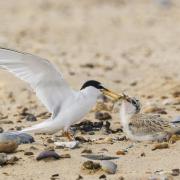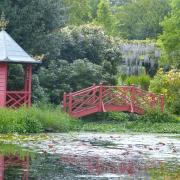The depths of winter… I’m in search of a walk that will blow away the cobwebs without leaving me (and the dog) caked in mud up to my knees (his armpits).
And as it’s the February issue, it would be nice if it had a romantic association. The answer lies in Felixstowe, where a brief chapter in the (arguably) greatest love story of the 20th century was written.
In October 1936, the American socialite Wallis Simpson spent six weeks in Felixstowe, to gain the residential qualifications needed for a divorce from her second husband to be heard at Ipswich Assizes.
Why Ipswich? Wallis needed it to be a low key affair. She was, after all, the woman Edward VIII had set his heart on, and divorcing Ernest Simpson would leave her free to marry the king.
Some hope. Associated Press got wind of the pending court case and the world’s press descended on Ipswich for hearing in St Helen’s Street on October 27.
After 25-minutes, Wallis got her decree nisi from an apparently sceptical Mr Justice Sir Anthony Hawke and, by all accounts, jumped into a car which whisked her back to London. Not Felixstowe; she’d seen enough of the charming coastal town.
Wallis Simpson divides opinion, but there’s no doubting her opinion of Felixstowe. She hated the place; we know this from her correspondence with poor, cast-off Ernest, since the pair remained friends.

Wallis stayed at Beach House, in Undercliff Road East, overlooking the North Sea. It was a graceful, six-bedroom mansion but she considered it a hovel; dingy, poky, hopelessly inadequate.
And Felixstowe was so far from the glamorous city life she craved, even though it was quite the fashionable seaside resort after Empress Augusta of Germany discovered it in 1891, believing her children would benefit from time spent breathing clean, fresh sea air.
Wallis was, after all, mean to be lying low, not that it stopped her friends dropping in for bracing walks along the beach. They failed to restore her spirits – she complained that no one recognised her.
In her autobiography, she wrote: ‘The only sounds were the melancholy boom of the sea breaking on the deserted beach and the rustling of the wind around the shuttered cottages.’ Well, it was the off-season.
‘No hint of distant concern penetrated Felixstowe. When I walked down to town for the mail and the newspapers not a head turned . . . on fair days, we used to walk alone on the beach and for all the attention ever paid to us, we could have been in Tasmania.’
Even Edward couldn’t keep away, landing his plane at Brackenbury Cliffs and enjoying a pint or two at The Fludyers Hotel, just up the road from Beach House.
Really, Wallis couldn’t have picked a better place than quiet, unassuming, discreet Suffolk to do what she needed to do, away from the world’s gaze. If only she’d had a better introduction to its numerous charms and historical significance.
This circular walk is quite long at 6.5 miles but it’s easy going and has lots to keep you interested along the way, including frequent opportunities for refreshment.
The walk
Start at Landguard Peninsula, the southerly point of Felixstowe, parking at the car park in front of Landguard Fort.
Landguard Peninsula is a fascinating area to explore, a combination of history, nature and commerce. The fort is one of England's best preserved coastal defences, and saw off the last opposed seaborne invasion of England in 1667. It’s played a role in defending Britain against Napoleonic invasion, as well as both World Wars.
Neighbouring Felixstowe Museum is packed with treasures and artefacts, telling the story of the area’s military, social and commercial history. Surrounding the Fort and Museum is Landguard Nature Reserve, grassland and coastal vegetated shingle habitats rich in flora and fauna.
The Landguard Bird Observatory, housed in a former military building, studies and records the reserve’s wildlife.

1. Head for the John Bradfield Viewing Area, beyond the fort, a great place to watch the comings and goings of Harwich Harbour and the Port of Felixstowe.
Walk along the shingle beach to the point, then bear left along a boardwalk and follow the beach, next to the reserve, reaching Landguard Common. Here you’re walking through grassy mounds ¬– gun butts - built by the military in the 1860s as a back drop to a firing range.
Continue through the car park to Manor Terrace, passing Landguard Lodge. This castellated, three-storey property, built about 1890, provided accommodation and messing facilities for Landguard Fort.
Manor House Hotel once stood here also, built by Colonel George Tomline in 1877, who brought the railway to Felixstowe in 1877 and created the dock basin that became Felixstowe Port.
The hotel wasn’t a success and later became Tomline used it as his summer residence. There was once a fabulous open air, sea-water swimming pool next door.
2. At the end of Manor Terrace, turn right to join the promenade. Along the length of the prom you’ll find information boards that offer interesting insights to various features as you pass them.
You can’t miss Martello Tower ‘P’, one of a series of 29 Martello towers built along the east coast between 1804 and 1812 as a defence against a potential invasion by Napoleon. There were once eight towers in Felixstowe; four remain and P is now a National Coastwatch station.
As you walk parallel to Sea Road, notice the several-storey Victorian and Edwardian houses overlooking the sea that would have been full of holiday makers in the 1920s and 1930s, enjoying Felixstowe’s seaside attractions including the brand new amusement park.
Opened in 1932 by one WE Butlin - later holiday camp king Sir Billy Butlin – the park has been run by the Manning family since 1946. Between 1933 and 1976 it was famous for its landmark wooden roller coaster. There was also a haunted house, ghost train, dodgems, a roller skating rink and a menagerie with an island for monkey.
3. Continue along the prom to Felixstowe Pier, splendid with its recently rebuilt pavilion. The pier was built in 1905 and was once one of the longest in the country with its own electric tramway running to the end. It was reduced in length in 1949.
It was also the stopping point for the ‘Belle’ paddle steamers which operated between London and Great Yarmouth. You can stop off at the excellent Boardwalk Café if you’re in need of refreshment.
Further along the prom you’ll reach the Spa Pavilion, opened in 1909 as The New Floral Hall. It soon became known as the Spa Pavilion and was completely re-vamped and extended in the late 1930s.
It re-opened as a large theatre and music hall in April 1939. What a pity Wallis was a few years too early to enjoy a show.
Stroll through the delightful Victorian and Edwardian Seafront Gardens. There are interpretation boards to explain the various features. At the end of the gardens rejoin the prom.

4. Just before the Fludyers Hotel, you’ll reach the spot in Undercliff Road East where Beach House once stood. It’s now a development of smart beach front homes; on the gate post is a plaque erected by the Felixstowe Society, made and sponsored by local artist Pat Todd and her late husband Mike.
The prom ends at Cobbolds Point, where in July 1667 a Dutch fleet landed 1,600 men, 400 of whom marched to Landguard Fort and launched an attack. They were beaten off by Captain Nathaniel Darell and his 200-strong garrison, the last time enemy troops landed on English soil.
5. Leave the promenade and walk up Brook Lane. Turn left into Rosebery Road, then left into Bath Road and right into Cobbold Road. You pass Harvest House, a magnificent red brick building that was opened in 1903 as the Felix Hotel.
For 50 years it was the place to stay in Felixstowe, with facilities for squash, tennis and croquet, and steps leading from the terrace to the beach. For 30 years it was the head office of fertiliser company Fisons and is now retirement apartments.
6. Turn left into Cambridge Road which leads into Hamilton Gardens. From up here there are terrific views to Landguard Peninsula and beyond. Look out to sea and you can make out the wartime Sealand fort, and much more recent wind turbines on the horizon.
At the junction with Hamilton Road and the top of Bent Hill, you’ll pass South Beach Mansion, which was where Empress Augusta of Germany stayed with two of her children in 1891.
Continue along the clifftop to the lookout, with its decorative pavement depicting shells, starfish and ships’ wheels. At the top of Convalescent Hill cross the road and continue along Wolsey Gardens, then turn right into Princes Road.
7. Take the next left into Victoria Road, then left again into Garfield Road, bearing right into Lincoln Terrace. Head down the unmade road to reach Garrison Lane. Cross over and walk past Lidl supermarket.
8. Turn right down a little lane to reach the entrance to Langer Park, between the road and the railway track. The park, with its shallow stream, is all that remains of Walton Creek, which ran from Felixstowe Dock Basin to the now demolished Ordnance Hotel (now Premier Inn) and was filled in when the railway line was built in 1875-77.
9. At the end of Langer Park you reach Walton Avenue. Turn left and at the traffic lights, go right into Langer Road, then left into Manor Road.
Follow the road to reach Manor Terrace and then follow the path back through the Nature Reserve to reach Landguard Fort car park.
COMPASS POINTS
Distance: 6.5 miles/10.5 km
Time: 3-4 hours
Access: Mostly firm tracks and surfaced paths, some sections along shingle and grassland. Mostly level; gradual climb to cliff top areas.
Parking: Landguard Peninsula car park, off View Point Road. IP11 3TW
Ts and Ps: numerous cafes, tea shops and kiosks; toilets at Landguard, pier, adjacent town hall, rear of Spa Pavilion, bottom of Bath Hill.




























